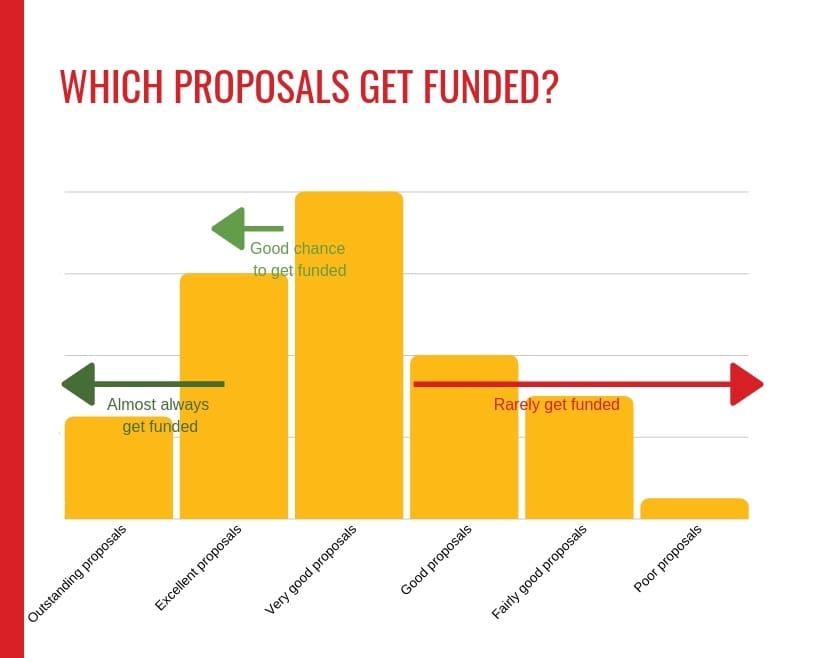
As a young engineering professor, you have a great idea for research. But you need funding to start. And that often means writing a research proposal.
The Ph.D. gave you good training in presenting research ideas, planning the work, and reporting the outcomes. Now imagine your graduate school could award the degrees to only 30% of all candidates. That’s how competitive the engineering research proposals are, whether submitted to internal university bodies or external agencies.
Excellent engineering research proposal wins
Your research proposal will be competing against submissions from established researchers from renowned universities. All of them have great research ideas, so how do you make sure yours get the attention of the reviewers, and, ultimately, the funding? You have to write a research proposal that is excellent, if not outstanding. Here is why:

The National Science Foundation (NSF), the biggest U.S. agency funding engineering research, received more than 40,000 proposals every year. Only about 11,000 get funded. The numbers from the British Engineering Physical Sciences Research Council, the Natural Sciences and Engineering Research Council of Canada, the Australian Research Council, or any other major funding agency would most likely be very similar. ‘Very good’ and ‘good’ is simply not good enough with such a level of competition. But how to write an excellent engineering research proposal?
The first impression your research proposal makes matters!
The first thing your research proposal reviewer will see is the project summary or project abstract. It is critical it catches the reviewer’s attention. Is your research idea aligned with the goals of the funding program and the agency? (We talked about the importance of selecting the right funding program in our previous blog post.)
Your project summary should describe your research idea, what makes your planned research novel and innovative, and why it is essential to learn more about the subject you chose. Explain why the research should be conducted, its expected outcomes and impact. Show the reviewer you are capable of performing such research and delivering results.
And make the summary easy to read for the reviewer– use figures and diagrams to convey the key idea of your proposal, add white spaces and highlight captions.
In most cases, the funding agencies publish on their websites summaries and abstracts of the projects that were awarded funding. It is a good idea to write them in a language the general audience can understand. The main project description should give you enough space for more scientific and technical details.
As we said previously, first impression matters. Excellent proposals do not underestimate grammar or neglect proof-reading. If you are sloppy in your writing, how should the reviewer be sure you won’t be equally sloppy in your research?
There are formal requirements for writing the research proposal!
No matter how good and captivating your project summary is, to make it to the next round, you still need to pass the formal criteria for the research proposal. Make sure you understand all the requirements! As long and boring as they may look, it’s not enough to skim through them.
Also, the requirements for different programs and funding agencies are different. Using your previous proposal as a template might be a good start, but make sure you adjust it for the new submission!
But let’s look at some of the most important formal criteria for proposals:
-
Deadline
Submission deadline is definitely something to pay attention to. The reviewers won’t read your proposal if it comes late by even 2 minutes. Try to submit your proposal 24 – 48 hours before the deadline. Leaving it to the last moment can put you at the mercy of technology, power outages, or slow internet connection, and that could mean a missed deadline.
-
Page limits
The length of the proposal is another important factor. If the page limit is 15 pages, your proposal shoudn’t be 20 pages long. Again, go through the proposal requirements carefully. Maybe the appendices are not included in the proposal page limit.
-
Page formatting
If you can’t squeeze your proposal into those 15 pages, cheating on formatting is not a way to go. With a smaller font size, reduced line spacing, or narrower margins, you would quickly make it into the ‘rejected’ pile (or folder).
-
Submitting files online
If you are submitting the proposal online, make sure you upload all the files and name them as required. Is the project summary or abstract supposed to be submitted separately? Should you include ‘project abstract’ in the file name?
Yes, you may think it’s the idea that should matter, not all these formalities. But remember, there are other proposals with equally great ideas, submitted on time, with proper length and formatting. All the requirements are there to simply ensure that the review process is fair, consistent, objective, and efficient.
Get more tips and help!
These are just a few tips to help you start with writing your research proposal. You can visit our website to see how our team can help you with your engineering research proposal. With multiple research projects awarded funding by external agencies, we have expertise and experience in preparing successful proposals.




